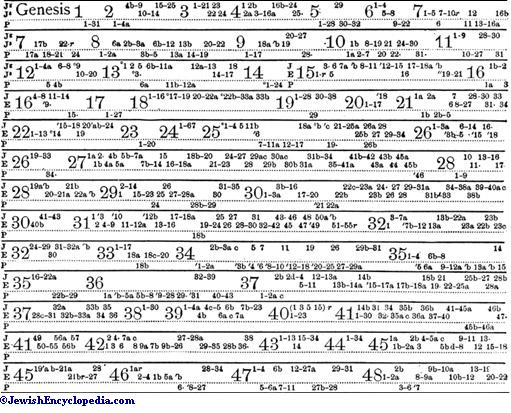Pentateuch
 From Jewish Encyclopedia (1906)
From Jewish Encyclopedia (1906) Pentateuch:
By: Emil G. Hirsch , Joseph Jacobs
The five books of Moses. The word is a Greek adaptation of the Hebrew expression "ḥamishshah ḥumshe ha-Torah" (five-fifths of the Law) applied to the books Genesis, Exodus, Leviticus, Numbers, and Deuteronomy, and indicating that these five books were to be taken as a whole, as they are in the first distinct reference to a division of the Biblical books by the Greek Sirach (see
Ancient Jewish tradition attributed the authorship of the Pentateuch (with the exception of thelast eight verses describing Moses' death) to Moses himself. But the many inconsiztencies and seeming contradictions contained in it attracted the attention of the Rabbis, who exercised their ingenuity in reconciling them. A catena of such reconciliations was given by Manasseh ben Israel in his "Conciliador" (1651). Abraham ibn Ezra was, however, the only Jewish exegete in the Middle Ages to cast any doubt upon the Mosaic authorship, and then only obscurely and with regard to a few detached passages, as in the instances of the reference to the Canaanite (Gen. xii. 6), that to Og's bedstead (Deut. iii. 11), and that to Moses (
ib.
xxxix. 9; see his commentary on Deut. i. 1). Spinoza, in his "Tractatus Theologico-Politicus" (1671, viii., ix.), goes so far as to attribute the composition of the Pentateuch not to Moses, but to Ezra, which view appears to have existed even in the time of the Apocrypha (comp. II Esd. xiv. 21-22). This and other denials of Mosaic authorship led to a new line of defense by Richard Simon, who regarded the Pentateuch as being made up by Moses from earlier documents. This was followed by the hypothesis of
Astruc
, that the book of Genesis was made up by Moses from two sources, one of which used the word "Elohim" for God, and the other "
- (1) The Jahvist, whose work is distinguished by the use of the name "Jahveh" (Wellhausen and Kuenen, J; Dillmann, B).
- (2) The Elohist, using the name "Elohim" (Wellhausen, E; Dillmann, C).
- (3) The Deuteronomist, who compiled Deuteronomy and "redacted" the Jahvist and Elohist narratives (Wellhausen, D; Dillmann, D).
- (4) The Priestly Narrative, beginning with Gen. i.-ii. 3 (Wellhausen, Q; Kuenen, P2; Dillmann, A).
- (5) The Priestly Code, containing the legislative sections of the middle books (Wellhausen, PC; Kuenen, P1; Dillmann, S).
Allowing, however, for editorial redaction, no less than twenty-eight different sources are distinguished by the latest analysis of Carpenter and Battersby ("The Hexateuch," p. xii., London, 1900). There is nowadays remarkable unanimity among the higher critics with regard to the attribution of the various sections of the Pentateuch to one or other of these five sources, though at times the text is by this means infinitesimally split up by merely formal criteria, as in Gen. xxvii., xxxi., xxxv.; Ex. iv., ix., xx.; Num. xiii.-xvi., xx. In the accompanying tables is given a summary account of the latest analysis as contained in Carpenter and Battersby ( l.c. i. 272-278).


As regards the age of these various sources there is considerable discrepancy of opinion, especially with regard to the Priestly Code and its accompanying narrative. While the older school, represented mainly by Dillmann, who is followed by Renan and Kittel in their histories of Israel, regarded this as the earliest source, to be placed in the ninth century
The arguments by which Wellhausen has almost entirely captured the whole body of contemporary Biblical critics are based on two assumptions: first,that ritual becomes more elaborate in the development of religion; secondly, that older sources necessarily deal with the earlier stages of ritual development. The former assumption is against the evidence of primitive cultures, and the latter finds no support in the evidence of ritual codes like those of India. Wellhausen's views are based almost exclusively on literal analysis, and will need to be supplemented by an examination from the point of view of institutional archeology. See also Bible Exegesis ; Hexateuch .

- Kuenen, Hexateuch, London, 1886;
- Wellhausen, Die Composition des Hexateuchs, Berlin, 1889;
- Holzinger, Einleitung in den Hexateuch. Freiburg, 1893;
- Carpenter and Battersby, The Hexateuch, London, 1900 (the chief recent works).
- On the relation of institutional archeology to Pentateuch criticism see Jacobs, Studies in Biblical Archæology, pp. 12-21.
- The chief Jewish opponent of the Wellhausen school is D. Hoffmann, Die Wichtigsten Instanzen Gegen die Graf-Wellhausensche Hypothese, Berlin, 1904.
Categories: [Jewish encyclopedia 1906]
↧ Download as ZWI file | Last modified: 09/04/2022 16:42:23 | 61 views
☰ Source: https://www.jewishencyclopedia.com/articles/12011-pentateuch.html | License: Public domain
 ZWI signed:
ZWI signed: KSF
KSF